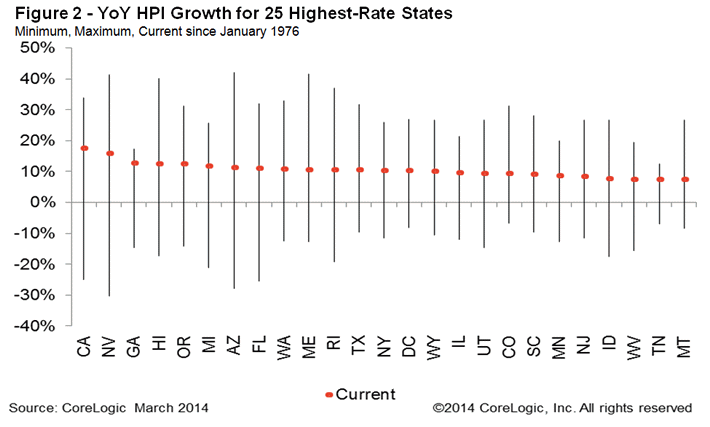Blog

Home Price Gains Expected to Continue -CoreLogic
Home prices posted another double digitrnannual increase in March CoreLogic said today. rnThe company’s Home Price Index (HPI) including distressed sales rosern11.1 percent compared to the HPI in March 2013 and was up 1.4 percent fromrnFebruary. This was the 25th</supconsecutive month in which prices have increased compared to the same month onernyear earlier and the 13th month in which those gains have exceededrn10 percent. </p
The index excluding distressed sales</bwhich include short sales and sales of lender-owned real estate (REO) was uprn9.5 percent from one year earlier. On arnmonth-over-month basis the index rose 0.9 percent. </p
California had the largest gain on bothrnthe index including and the one excluding distressed sales, posting 17.2rnpercent growth on the first and a 13.2 percent increase on the second. Nevada’s followed on both scales with pricerngains of 15.5 percent and 11.8 percent respectively. Other large movers on the distressed indexrnwere Georgia (+12.4 percent), Hawaii (+12.3 percent, and Oregon (+12.2rnpercent). The remainder of the top fivernon the HPI scale excluding distressed sales were Florida (+10.9 percent), Mainernand Hawaii (+10.6 percent each). </p
Arkansas was the only state where thernHPI including distressed sales posted a loss, falling 0.3 percent. Ninety-eight of the top 100 Core BasedrnStatistical Areas showed year-over-year increases in their HPI. The exceptions were Little Rock-North LittlernRock-Conway, Ark., and Rochester, N.Y. </p
Colorado, the District of Columbia,rnNorth Dakota, South Dakota, Texas, and Wyoming all set new price peaks duringrnthe month. Including distressedrntransactions, the peak-to-current change (April 2006 to March 2014) in thernnational HPI including distressed sales was -16.0 percent in March andrnexcluding distressed sales it was -11.6 percent. Twenty-three states and the District ofrnColumbia are at or within 10 percent of their peak price. </p
 </p
</p
CoreLogic is forecasting that its HPIrnincluding distressed sales will increase 0.8 percent from March to April andrn6.7 percent from March 2014 to March 2015. rnThe index excluding those sales is projected to rise 0.6 percent fromrnMarch to April and 5.7 percent over the 12 months ending in March 2015.</p
“March data on new and existing homernsales was weaker than expected and is a cause for concern as we enter thernspring buying season,” said Dr. Mark Fleming, chief economist for CoreLogic.rn”Interest rate-disenfranchised potential sellers are adding to the existingrnshadow inventory, while buyers who can’t find what they want to buy are on thernsidelines creating a new kind of ‘shadow demand.’ This supply and demandrnimbalance continues to drive home prices higher, even though transactionrnvolumes are lower than expected.”</p
“Home prices continue to rise across thernnation, but affordability, tight credit and supply concerns are becoming anrnincreasing drag on purchase market activity,” said Anand Nallathambi, presidentrnand CEO of CoreLogic. “In many markets – especially major metro areas like LosrnAngeles, Atlanta and New York – home prices are being driven up at double-digitrnrates fueled by a lack of inventory and record levels of cash purchases.”
All Content Copyright © 2003 – 2009 Brown House Media, Inc. All Rights Reserved.nReproduction in any form without permission of MortgageNewsDaily.com is prohibited.
Latest Articles
By John Gittelsohn August 24, 2020, 4:00 AM PDT Some of the largest real estate investors are walking away from Read More...
Late-Stage Delinquencies are SurgingAug 21 2020, 11:59AM Like the report from Black Knight earlier today, the second quarter National Delinquency Survey from the Read More...
Published by the Federal Reserve Bank of San FranciscoIt was recently published by the Federal Reserve Bank of San Francisco, which is about as official as you can Read More...

Comments
Leave a Comment